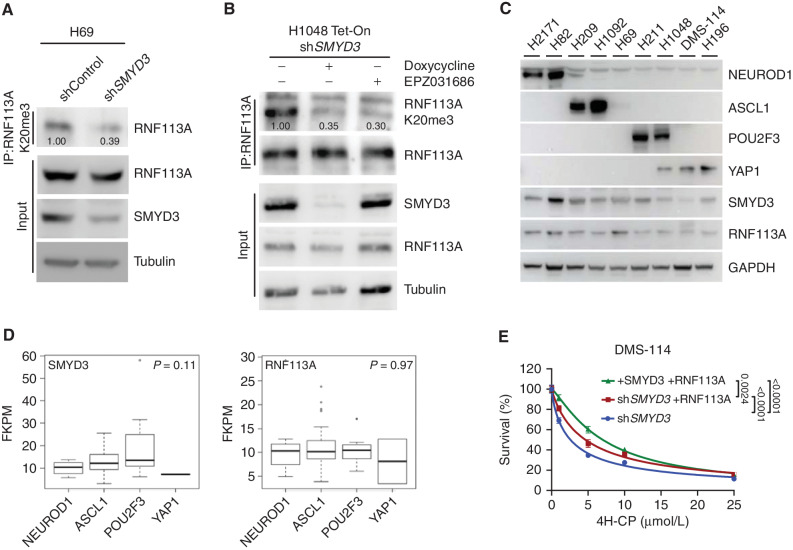Figure 3.
SMYD3–RNF113A methylation signaling in SCLC cell lines. A, Immunodetection of endogenous RNF113A K20me3 following immunoprecipitation of total RNF113A in SCLC H69 cells transduced with shRNA targeting SMYD3 (shSMYD3) and a control nontargeting shRNA (shControl). Tubulin was used as a loading control. B, Immunoblot analysis with indicated antibodies as in A of H1048 SCLC cells expressing doxycycline-inducible shSMYD3 or treated with SMYD3i (EPZ031686). Tubulin was used as a loading control. C, Immunoblot analysis with indicated antibodies using lysates obtained from human SCLC cell lines representing all four molecular subtypes (NAPY) classified by expression of specific markers (NEUROD1+; ASCL1+; POU2F3+; YAP1+). GAPDH was used as a loading control. D,SMYD3 and RNF113A expression in human samples representing different molecular SCLC subtypes. Boxes represent 25th to 75th percentiles; whiskers: 10% to 90%; center line: median. P values were calculated by the Kruskal–Wallis test. Analyses were performed using FPKM data for each specified gene obtained from ref. 34. NAPY SCLC subclassification was based on the original classification from ref. 32. E, Analysis of DMS-114 SCLC cell line growth response to increasing concentrations of 4H-CP. Cells were transduced with doxycycline-inducible shSMYD3 and complemented with the expression of RNF113A or both SMYD3 and RNF113A. The percentage of viable cells under each condition was normalized to vehicle-treated (control) cells. Each condition represents the mean of three technical replicates from two independent experiments. P values were calculated by two-way ANOVA with the Tukey test for multiple comparisons. Data are represented as nonlinear regression with mean ± SEM. In all panels, representative of at least three independent experiments is shown unless stated otherwise. The numbers below the immunoblot lines represent the relative signal quantification (see also Supplementary Table S5).

